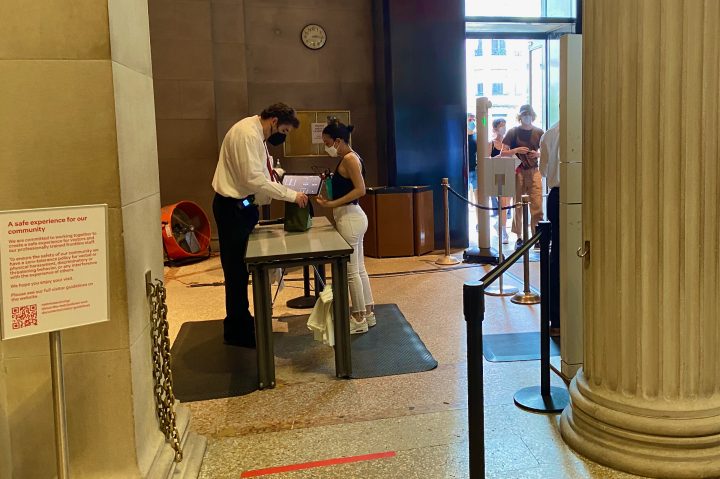
Whether I’m visiting the museum or the city jail, it’s the same routine: the bus ride downtown, the intimidating building, waiting on line, the guards opening my purse and smirking at tampons and candy wrappers, the random decision not to allow this empty water bottle, that medication, the forgotten crochet hook. Then it’s a metal check, wanding, waiting, showing a card. Finally, inside the jail, I get to see my friend. But we’re not face to face. They’re still behind thick glass, speaking on a scratchy phone. I’m surrounded by leering guards. Watch what you say! Everything is recorded, overheard, seen by cameras and secret security devices. Inside the museum, the visit is eerily parallel. It’s objects, not people, but they’re still behind glass. We’re still surrounded by guards and security cameras.
The development office thinks I love this museum. I get fundraising emails addressed to “Friends of the Museum,” and to patrons and members. But no, I come to see the objects, just like I visit my friends. It’s not that I’m personally uncomfortable in the museum. After all, I’m an archaeologist: I’ve worked in several museums, and visited dozens more. Once I’m past security, the museum is friendly to me, and I know my way around, how to behave, what not to touch. But I’m White. I’m one of the colonialists. The museum was built for me, but almost everything in the cases came from places that didn’t want to see the things go. I’m sad that the artworks are stuck so far from home, and angry at the way the museum (mis)represents them. Their friends at home miss them, I know.
When I see my friends in jail, they seem strange, out of context. They’re not sitting on my porch or standing by my shoulder shouting slogans. They’ve been dealing with things I don’t know about, somewhere in that world behind the glass. Only their head and shoulders and arms appear, no legs, no butt, no belly tattoo. But my friends are only in for a few nights in the city jail; these objects are serving several life sentences, stacked. This is really prison, not jail.
The museum, too, takes their objects out of context. When Egyptian and Costa Rican tourists come to visit, do they remember that this was once a gravestone, and stood in a cemetery; that this was a baby’s bottle, and her mother held her bottle and snuggled her; that women wove this dress in the workroom of some forgotten temple, thousands of miles from here?

In museums and in jail, everything is mixed up together. In jail, nobody cares what you did. You’re there because you’re a criminal, and criminals belong in jail. Embezzlers, protesters, junkies: They’re all jumbled up together behind the same glass. In the museum, the objects are there because they’re valuable, and they’re jumbled too. A few yards takes you to a different continent or a different century. That’s the point, to control all of space and time. The jail shows the power of the state, that it can lock up all sorts of people. The museum embodies the power of colonialists to seize paintings and sculpture and pottery from all over the world and bring them to our city and lock them in glass boxes. The police arrest the protesters, and colonizing armies confiscate the art.

The label tells us curated facts, or thoughts, about the object. The label says this palm-size Costa Rican greenstone raptor was precious, was traded from place to place, was sacred, but it won’t use the word “money.” Money is for the colonizers, not the colonized. Even though our own money, too, is palm-sized, and green, and ornamented with raptors.
Stand up and look around: it’s not just the labels that try to pull you into complicity, that work to assimilate you to the colonizers. Curators placed this glass bowl, made in Egypt or Syria long before Europeans knew how to melt sand into glass, in the Greek and Roman galleries, not in the Egyptian galleries, because glass is technological, and technology belongs to Europeans. But what about these wooden models of butcher shops — why are they in a dark room? Oh, it’s Egypt, costumed as darkest Africa.

But already the guards are approaching. Incomprehensible announcements emerge from unseen intercoms. Visiting hours are over. We have to leave our friends here in the jail, the objects here in the museum, and we go out again into the heat and sunshine, into the world of coffee and churches and protests and shopping and home. They stay behind, for now. Oh, sure, the Euphronios Krater went back to Italy. The silver cups of the Lydian Hoard went back to Turkey. My friends are back out on the streets now. But they should all be at home, my protesting friends and I, and the bowls and sculptures and models: they should be home in their own surroundings, happy, free.
(For more on the movement to repatriate objects from museums, read Dan Hicks, The Brutish Museums: The Benin Bronzes, Colonial Violence and Cultural Restitution, published by Pluto Press in 2020.)
0 Commentaires